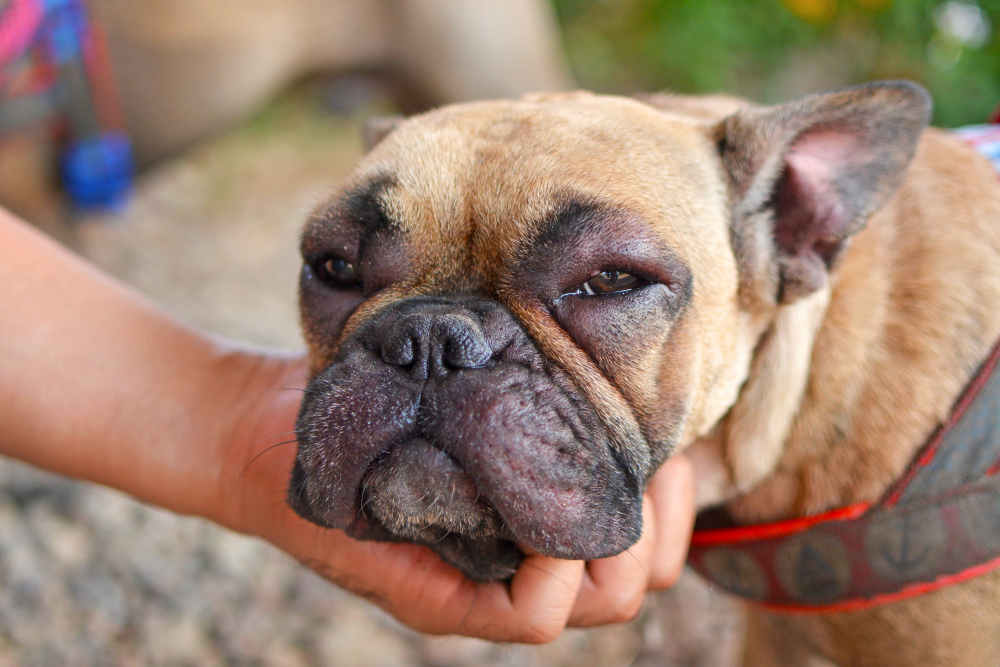Allergic pets, like people, can react to a vast array of triggers, and respond in various levels of severity. Whether your pet’s response is a mild itch or a life-threatening anaphylactic shock, you need to know how to help your four-legged friend who is having an allergic reaction. To help guide you through an allergy event, our Central Kentucky Veterinary Center team outlines five steps that will help your pet.
Step 1: Identify what caused the allergic reaction in your pet
Since virtually anything can trigger your pet’s allergic reaction, identifying the culprit is key to successful treatment and future avoidance. Some of the most common pet allergens include:
- Environmental allergens — Pets can inhale environmental allergens, which leads to generalized allergic reactions, or they can react at the point of contact, such as on the paws or abdomen. Pets are commonly allergic to trees, grasses, pollens, mold spores, and dust and house mites.
- Bug and insect allergens — Fleas are the top culprit in the “bug” allergy category, but any biting or stinging insect can spur an allergic reaction. Pets who are flea-allergic are hypersensitive to a protein in flea saliva, and can erupt in an itchy rash after only a handful of flea bites. Bees, wasps, and ants can also sting or bite a pet and cause painful swelling or a more severe reaction, depending on the number of bites.
- Food allergens — True food allergies are uncommon in pets, but sensitivity to the protein in a pet’s diet can trigger generalized inflammation and gastrointestinal (GI) problems. The most common food allergens for pets include chicken, lamb, beef, dairy, eggs, fish, and soy.
The best way to determine your pet’s environmental allergies is through blood testing, while dietary trials can help pinpoint food allergens.
Step 2: Remove the offending allergen, if possible
Take these steps to minimize your pet’s allergic reaction:
- Bees — If your pet is stung by a bee, scrape out the stinger with a credit card, taking care not to squeeze the stinger, because more venom will be injected into your pet.
- Fleas — Contact us for a flea treatment medication that will kill all the fleas on your pet. Administering a quality flea preventive and treating your environment will kill off remaining fleas and protect your pet.
- Food — If your pet is allergic to a certain protein, eliminate that ingredient from their diet.
Step 3: Contact your veterinarian
Your Central Kentucky Veterinary Center veterinarian will provide the best advice and most effective treatments for your pet’s allergies. We can also guide you on whether you can remedy your pet’s allergic reaction at home, or if you need to head to our hospital immediately for an anaphylactic reaction that needs powerful treatment.
Depending on the allergic reaction’s cause and intensity, your pet may be fine with a few doses of an antihistamine at home, or may require an intravenous (IV) catheter, fluid therapy, injectable medications, and intensive nursing care.
If your pet’s allergic reaction is because of seasonal chronic allergies, our team will work with you to create an effective treatment plan to reduce the itching, irritation, and inflammation. Allergy therapies may include:
- Antihistamines
- Corticosteroids
- Immunosuppressive medications
- Targeted anti-itch medications (i.e., Apoquel, Cytopoint)
- Immunotherapy
- Medicated shampoos
- Topical medications and ointments
- Skin supplements
- Prescription diets
Step 4: Monitor your pet’s condition
If your pet is having an acute allergic reaction to a bee sting or medication, for example, monitor their condition closely. Typically, life-threatening issues are visible shortly after exposure, sometimes in minutes, but facial swelling and respiratory distress can develop slowly. Keep a close eye on your four-legged friend to ensure they are improving, and that they can breathe comfortably as they recover. If their condition worsens, they will need emergency veterinary care.
Step 5: Minimize future exposure risk

Allergies in pets tend to worsen over time, but by learning what triggers your pet’s allergy, you can reduce their exposure and keep them comfortable. For example, if you know your pet is allergic to springtime pollen, limit their outdoor activities and let them exercise and play inside. Also, an air purifier can reduce pollen inside your home, and skin- and immune-supporting supplements can help shore up your pet’s defenses against allergens.
Allergies not only make your pet miserable, but can also lead to life-threatening reactions. For help managing every level of your furry pal’s allergic reactions, contact our Central Kentucky Veterinary Center team.







Leave A Comment